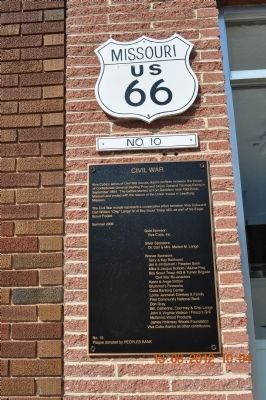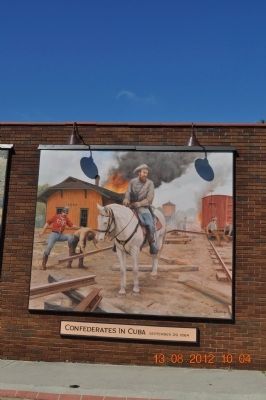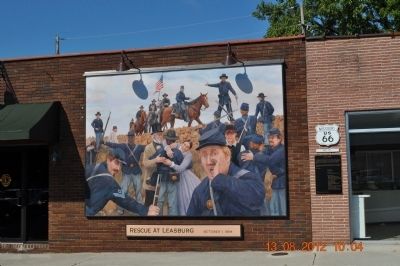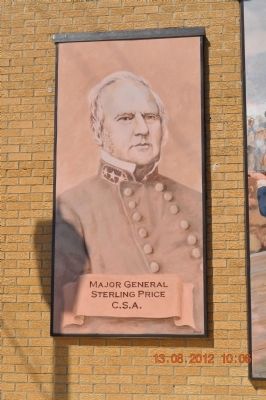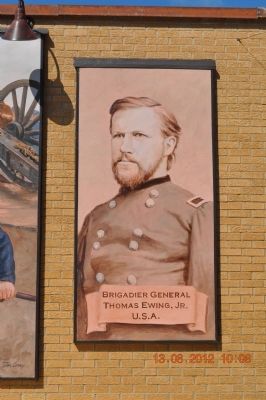Cuba in Crawford County, Missouri — The American Midwest (Upper Plains)
Civil War
The Civil War murals represent a cooperative effort between Viva Cuba and Carl William "Chip" Lange IV of Boy Scout Troop 463, as a part of his Eagle Scout Project.
Gold Sponsor:
Viva Cuba, Inc.
Silver Sponsors:
Dr. Carl & Mrs. Marion M. Lange
Bronze Sponsors:
Terry & Kay Balthazor
Jim & JIll Barnett/Peoples Bank
Mike & Jacque
BottomAluma Flag
Boy Scout Troop 463 & Turner Brigade Civil War Re-enactors
Kevin & Angie Britton
Bummet's Fireworks
Cuba Banking Center
Lorrie Janowiak Ellerbee and Family
First Community National Bank
Don Gray
Bill, Catherine, Courtney & Chip Lange
John & Virginia Watson/Frisco's Grill
McGinnis Wood Products
James Holloway Woods Foundation
Viva Cuba thanks all other contributors.
Erected 2005 by Plaque donated by Peoples Bank. (Marker Number 10.)
Topics. This historical marker is listed in this topic list: War, US Civil. A significant historical month for this entry is September 1864.
Location. 38° 3.696′ N, 91° 24.377′ W. Marker is in Cuba, Missouri, in Crawford County. Marker is on Buchanan Street, on the right when traveling south. Touch for map. Marker is at or near this postal address: 114 Buchanan Street, Cuba MO 65453, United States of America. Touch for directions.
Other nearby markers. At least 8 other markers are within walking distance of this marker. Meeting in Missouri (here, next to this marker); Confederates in Cuba (a few steps from this marker); Battle of Pilot Knob (a few steps from this marker); Peoples Bank (within shouting distance of this marker); Apples and Barrels (within shouting distance of this marker); Prosperity Corner (within shouting distance of this marker); Cuba's Gold Star Boys aboard the Blue Bonnet Frisco Train (within shouting distance of this marker); County Fair (about 400 feet away, measured in a direct line). Touch for a list and map of all markers in Cuba.
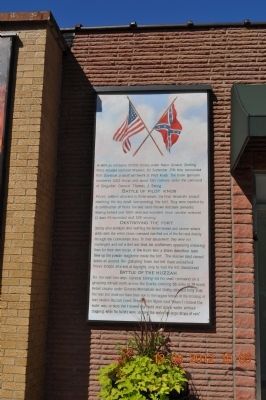
Photographed By Sandra Hughes, August 13, 2012
2. Civil War Marker
In 1864, an estimated 12,000 troops under Major General Sterling Price invaded southeast Missouri. On September 27th they surrounded Fort Davidson, a small earthwork at Pilot Knob. The Union garrison numbered 1262 troops and about 150 civilians. under the command of Brigadier General Thomas J. Ewing.
BATTLE OF PLIOT KNOB
Price's soldiers attacked in three waves, the final desperate assault reaching the dry moat surrounding the fort. They were repelled by a combination of fierce fire and hand-thrown Ketcham grenades, leaving behind over 1000 dead and wounded. Union casualties numbered 12 dead, 65 wounded and 129 missing.
DESTROYING THE FORT
Shortly after midnight, after muffling the horse's hooves and cannon wheels with cloth, the entire Union command marched out of the fort and directly through the Confederate lines. To their amazement, they were not challenged and not a shot was fired, the southerners apparently mistaking them for their own troops. A few hours later a Union demolition team blew up the powder magazine inside the fort. The massive blast rained debris all around the galloping team, but left them untouched. Price's troops attacked at daylight, only to find the fort abandoned.
BATTLE OF THE HUZZAH
For the next two day, General Ewing led his small command on a grueling retreat north across the Ozarks, covering 66 miles in 39 hours. Rebel cavalry under Generals Marmaduke and Shelby attacked hotly from the rear, but could not flank them due to the rugged terrain. At the crossing of rain-swollen Huzzah Creek, Private John Wynn said, "When I crossed the water was so deep that I bowed my head and drank water without stopping, while bullets were striking the water lake large drops of rain."
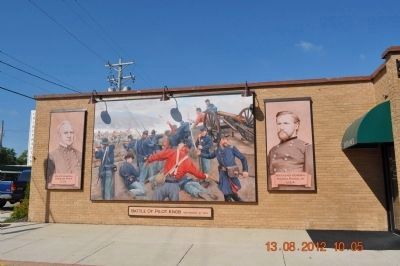
Photographed By Sandra Hughes, August 13, 2012
3. Battle Of Pliot Knob
Price's soldiers attacked in three waves, the final desperate assault reaching the dry moat surrounding the fort. They were repelled by a combination of fierce fire and hand-thrown Ketcham grenades, leaving behind over 1000 dead and wounded. Union casualties numbered 12 dead, 65 wounded and 129 missing.
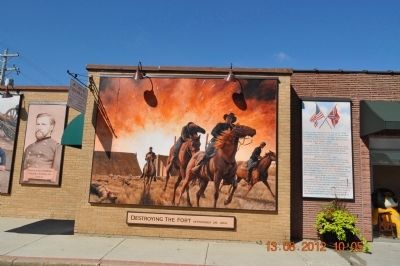
Photographed By Sandra Hughes, August 13, 2012
6. Destroying the Fort
DESTROYING THE FORT
Shortly after midnight, after muffling the horse's hooves and cannon wheels with cloth, the entire Union command marched out of the fort and directly through the Confederate lines. To their amazement, they were not challenged and not a shot was fired, the southerners apparently mistaking them for their own troops. A few hours later a Union demolition team blew up the powder magazine inside the fort. The massive blast rained debris all around the galloping team, but left them untouched. Price's troops attacked at daylight, only to find the fort abandoned.
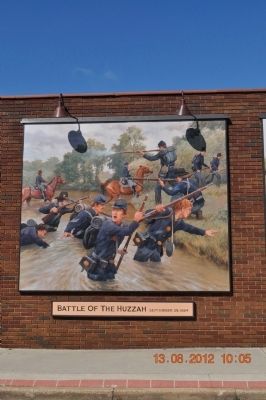
Photographed By Sandra Hughes, August 13, 2012
7. Battle Of The Huzzah
For the next two day, General Ewing led his small command on a grueling retreat north across the Ozarks, covering 66 miles in 39 hours. Rebel cavalry under Generals Marmaduke and Shelby attacked hotly from the rear, but could not flank them due to the rugged terrain. At the crossing of rain-swollen Huzzah Creek, Private John Wynn said, "When I crossed the water was so deep that I bowed my head and drank water without stopping, while bullets were striking the water lake large drops of rain."
Credits. This page was last revised on June 16, 2016. It was originally submitted on August 28, 2012, by Sandra Hughes Tidwell of Killen, Alabama, USA. This page has been viewed 900 times since then and 30 times this year. Photos: 1, 2, 3, 4, 5, 6, 7. submitted on August 28, 2012, by Sandra Hughes Tidwell of Killen, Alabama, USA. 8, 9. submitted on August 29, 2012, by Sandra Hughes Tidwell of Killen, Alabama, USA. • Craig Swain was the editor who published this page.
